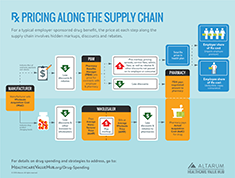Improving Value
Drugs - Regulating Pharmacy Benefit Managers
Pharmacy benefit managers (PBMs) are third-party contractors who work with health insurers to administer pharmacy benefits. PBMs often design prescription drug formularies—lists of drugs covered by a health plan–and determine the cost-sharing tier for each covered drug. PBMs also negotiate rebates with drug makers, but these negotiations are often kept confidential. Some of reimbursement amount is based on the drugs’ list price—potentially incentivizing PBMs to prioritize high-cost drugs. Drug companies also give PBMs volume-based rebates in order to keep generics off the formulary. This has caused some stakeholders to worry that PBMs may not be passing savings on to consumers and are contributing to rising drug prices. This can cause affordability burdens for consumers, particularly for those whose cost-sharing is based on a percentage of the drug’s list price or if they have a high-deductible health plan.1
However, other reports have found that PBMs have been able to garner larger rebates from manufacturers, contributing to lower net prices of prescription drugs and lowering the rate of growth of prescription drug spending.2
Furthermore, the industry is becoming more consolidated, increasing PBMs’ bargaining power by stifling competition. Many mergers and acquisitions during the 2000s have resulted in three PBMs controlling about 80 percent of the market.3 In 2022, the FTC declined to investigate PMB actions, leaving the industry to continue its practices, without federal antitrust oversight.4
PBMs typically do not have a fiduciary obligation to prioritize a health plan beneficiary’s best interest. A fiduciary duty is the legal obligation of one party to act in the best interest of another, for example, the best interest of the consumer. Health plans and PBMs are regulated either by state insurance regulators or the U.S. Department of Labor (DOL). Courts have uniformly ruled that the Employee Retirement Income Security Act (ERISA), a law overseen by the DOL to set minimum standards for most voluntarily established pension and health plans to provide protections for enrollees, does not apply to PBMs.5
A study commissioned by the Ohio Department of Medicaid found that PBMs were engaging in “spread pricing,” a practice where PBMs charge health plans and employers a higher price than what they actually pay pharmacies for the drugs, and pocket the difference.6 The report showed that there was an 8.8 percent difference between what was billed to managed care plans and paid to pharmacies in the state.7
Conversely, an Altarum study found that rebates negotiated by PBMs benefitted both consumers and payers–lowering government costs and contributing to lower premiums. Medicare Part D plans achieved larger rebates than private plans. However, the authors noted that PBMs have gained financially from the rebate system, earning approximately $11 billion in profits in 2016.8
State legislation regulating PBMs aim to shed light on their opaque business practices in several ways. These include: banning gag clauses that prevent pharmacists from revealing lower-cost options to consumers; requiring PBMs to be licensed by the state; mandating that PBMs disclose whether a generic is available; limiting cost-sharing; preventing PBMs from charging plans more than what a pharmacy paid; and requiring PBMs to report pricing and rebate information to promote transparency.
Arkansas requires PBMs to reimburse pharmacies equal to or higher than the pharmacy’s wholesale cost, due to concerns that PBM reimbursements to pharmacies were too low to cover the pharmacy’s costs. The Supreme Court upheld the law in 2020, paving the way for other states to enact similar regulations, particularly regarding PBM pricing arrangements.9
Notes
- Seeley, Elizabeth and Aaron S. Kesselheim, “Pharmacy Benefit Managers: Practices, Controversies, and What Lies Ahead,” The Commonwealth Fund, New York, N.Y. (March 26, 2019).
- Cuckler, Gigi A., et al., “National Health Expenditure Projections, 2017–26: Despite Uncertainty, Fundamentals Primarily Drive Spending Growth,” Health Affairs, Vol. 37, No. 3 (Feb. 14, 2018).
- Axios, FTC May Probe Pharmacy Benefit Managers, https://www.axios.com/ftc-study-pharmacy-benefit-managers-drug-prices-3078116f-382a-4b05-ac62-da5bc1d1b892.html (accessed on April 14, 2022.
- Bean, Mackenzie, “FTC Probe of Pharmacy Benefit Managers Stalled After Tie Vote,” Becker’s Hospital Review (Feb. 17, 2022).
- Eskew, Philip, Villains of Health Care Series #1: PBMs (Jan. 8, 2017).
- Royce, Trevor J., et al., “Pharmacy Benefit Manager Reform: Lessons from Ohio,” Journal of the American Medical Association, Vol. 322, No. 4 (June 20, 2019).
- Auditor of State of Ohio, Ohio’s Medicaid Managed Care Pharmacy Services, Columbus, OH (Aug. 16, 2018).
- Roehrig, Charles, The Impact of Prescription Drug Rebates on Health Plans and Consumers, Altarum, Ann Arbor, Mich. (April 2018).
- JD Supra, New Supreme Court Ruling Affirms State Regulation of PBM Reimbursement Pricing, https://www.jdsupra.com/legalnews/new-supreme-court-ruling-affirms-state-2371638/#:~:text=The%20U.S.%20Supreme%20Court%20ruled,7250098%20(U.S.%202020) (accessed on April 13, 2022).







